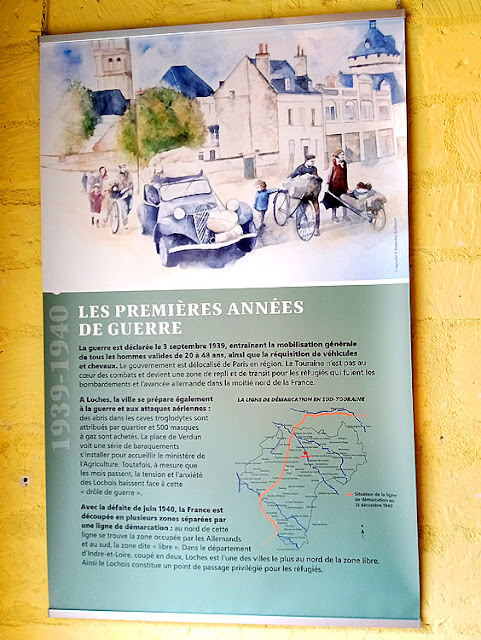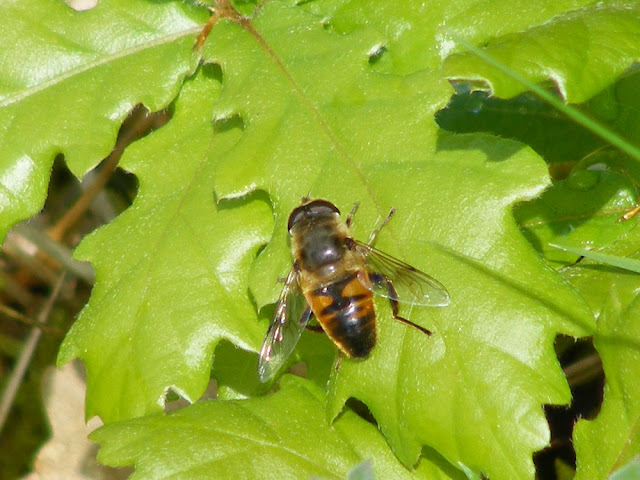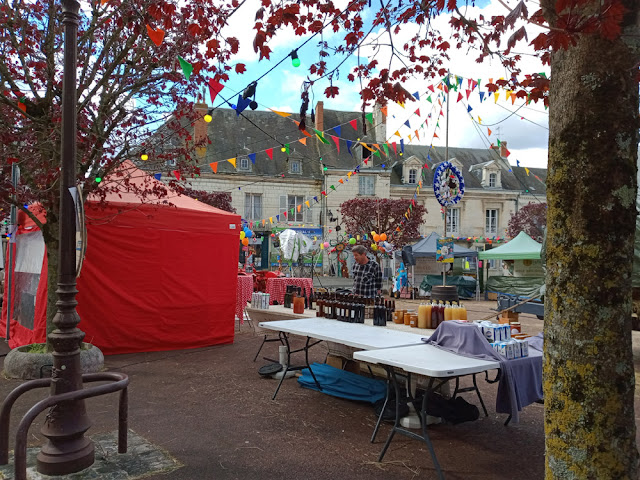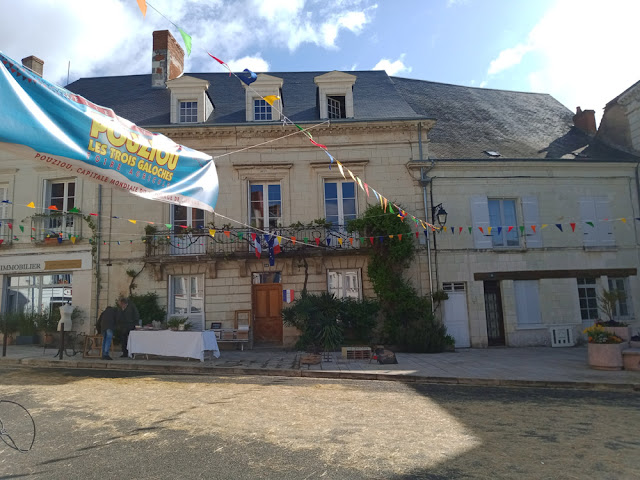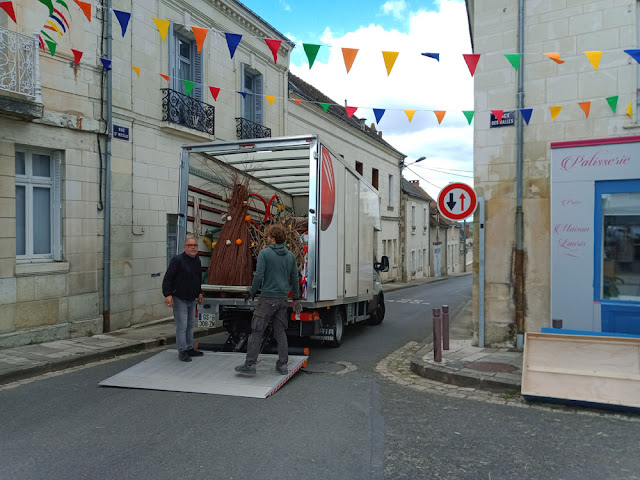That means that (unwittingly) my question "what sort of fish is Colin" was valid. It just didn't sound clever.
Friday, 31 May 2024
A Fish Named Colin
That means that (unwittingly) my question "what sort of fish is Colin" was valid. It just didn't sound clever.
Thursday, 30 May 2024
Looking Good
Wednesday, 29 May 2024
Monday May 29, 2006
Tuesday, 28 May 2024
Once Upon a Time in Loches -- a 'Free' Town 1940 - 1942
"The town of Loches was not immediately in the 'free' zone. In fact, following an administrative error Loches found itself in the Occupied Zone from 21 June to 11 July 1940. The Germans set themselves up in Rue Picois and in the barracks on Place de Verdun for a month. From 11 July, after the error was rectified, it was the Vichy Army which were installed at both Loches and Perusson.
The daily life of the residents of Loches and the surrounding countryside in the 'Free' Zone had a routine dictated by requisitions and rationning. The ration cards and tickets were distributed by the Town Hall. They covered not only food, like bread, flour or eggs, but also supplies such as petrol, wood or even coal. Because of this, the black market and resourcefulness became the solution for many inhabitants, despite the difficulties and the illegality that it entailed.
The Vichy Regime controlled the town at different levels. A new sub-prefet and municipal council were appointed directly by the Government, who placed conviction Pétainists in charge of the town. Numerous streets were renamed, like the Manthelan road, which became Avenue Maréchal du Pétain. The local press was controlled and censored. The Ecole normale, which trained teachers, was closed. To ensure security in the area the 32nd Infantry Regiment, who were under the control of the Vichy Government, were installed in Loches, so it became a garrison town."
****************************************
Note: The 32nd Infantry Regiment was traditionally made up of men from the Touraine, so they were locals, who knew the geography and the people.
This poster is part of an exhibition in the Chancellerie on 'Loches in 1944' https://www.ville-loches.fr/expositions-article-3-10-56.html
Monday, 27 May 2024
The Massed Steve Show
Saturday, 25 May 2024
Isn't That Strange
Friday, 24 May 2024
The History of China Clay and la Cabane
On Saturday I am leading an outing with ecologist Francois Lefebvre to one of our favourite nature sites, la Cabane, on behalf of the Association de Patrimoine Vivant de la Claise Tourangelle (PVCT), the Association de Prehistoire et d'Archaeology de Bossay (APAB) and the Association de Botanique et de Mycologie de Sainte Maure de Touraine (Botamyco37). As we wanted to focus on both the industrial and the natural history of the site I have prepared a document on the history of the china clay (Fr. kaolin) extraction on the site. Those participating in the outing will get it in French on the day, blog readers will get it here in English.
*******************************************
Kaolin, or ‘china clay’ as it is commonly called in English, is a rock from which the clay mineral kaolinite is derived. This has been used for many years as the principal ingredient in porcelain tableware. Today its uses range from paper to paints, fiberglass to cosmetics and pharmaceuticals, as well as in sanitary porcelain.
Kaolin is a hydrated aluminum silicate crystalline mineral formed over many millions of years by the hydrothermal decomposition of granite, feldspars, mica and quartz sands. The clay can be modified using high temperatures to create products with different characteristics eg whiter, harder, better electrical conductivity.
Clay storage hangars at Imerys Ceramics, Tournon Saint Martin.
The discovery of kaolin in Saint-Yrieix-la-Perche (Haute Vienne) in the late 1760s was pivotal for the local economy. This high-quality white clay became essential for the porcelain industry, particularly benefitting the famous Limoges porcelain manufacturers. By the 19th century, Indre's kaolin mines, notably in the town of Argenton-sur-Creuse, were thriving. These deposits contributed significantly to the region's economic development, enabling the production of fine porcelain that gained international acclaim.
However, by the late 20th century, the industry faced decline due to the depletion of easily accessible deposits and competition from kaolin sources worldwide. Despite this downturn, the historical impact of kaolin extraction remains evident. Today the activity continues with Imerys Ceramics, based in Tournon Saint Martin, and one of the largest kaolin producers in the world.
Imerys Ceramics, Tournon Saint Martin.
At la Cabane, an initial request to quarry was made by Denain-Anzin Mineraux in 1972 but there had been a quarry on the site since 1964 and Denain-Anzin Mineraux had been active in the area since 1959. The company sold their mining business in Indre, Indre et Loire and Vienne and the equipment associated with it to WBB de France for 35 000 francs in 1978. WBB continued to exploit la Cabane until 1983, when the quarry was abandoned. The equipment at the time of the sale included three trucks, a loader and two diggers, as well as clay drying and processing equipment and two storage hangars at Tournan Saint Martin station. WBB de France was a French branch of a British company based in Devon called Watts, Blake, Bearn and Company Limited. Denain-Anzin Mineraux were bought out by Imerys in 2005 and WBB no longer exists.
The land was owned by a third party and Denain-Anzin only had the mineral extraction rights on 7 hectares at la Cabane and la Touche au lard. The industrial clay was from one to three metres thick, under two to five metres of topsoil, sand and gravel. It was extracted from an open cut mine by hydraulic digger. In the three years prior to September 1971, just over ten thousand tonnes of clay had been extracted, destined for ceramics factories. The site was divided into zones, each of which was dug successively. The top soil was removed, the clay extracted, then the exhausted zone was back filled with the topsoil from the next zone. Denzain-Anzin Mineraux was obliged by the terms of their mining licence to restore the land to a state where it could be cultivated, and all infrastructure was supposed to be removed. The remains of the quarry itself had to be left with clean stable sides, and if there was a risk it would be used as a rubbish dump, Denzain-Anzin Mineraux were obliged to fence it off before they left.
What the quarry looks like now.
WBB de France exported 75% of the half a million tonnes annually of clay they excavated globally to their subsidiary in Germany. They operated four quarries near Tournon Saint Martin and in 1977 sold 13 000 tonnes from this production, 30% of it exported. After investment in equipment production was expected to rise to 30 000 tonnes. Their local manager was Monsieur P. Andrei, and everyone I spoke to referenced him as the person I should go to for information, but sadly I understand that he has now died. His boss was an English engineer called Geoffrey Dawes. I had hoped to get an idea of the day to day working of the enterprise, but although I spoke to a relative and others who knew Monsieur Andrei, no one was able to give me any details. Imerys Ceramics did not respond to my email. My understanding is that the clay was loaded on to trucks and transported to the railway station at Tournon Saint Martin, where it was stored for subsequent transportation by rail to Germany. What I have been unable to work out is at what point the clay was dried, but it must have been either on site at la Cabane or at the storage facility in Tournon Saint Martin.
When the business changed hands in 1978 the Prefecture, the sub-prefecture at Loches, the mayor of Bossay sur Claise, the State Service for Industry and Mines, the Directors of the Departmental Equipment, Agriculture, and Antiquities services and the Architect for Batiment de France (historic architecture and monuments) were consulted and had to give their permission. The Departmental Mines Engineer and the Gendarmes were notified.
The gap between the trees is the dam wall dividing the quarry from the drainage ditch.
When WBB decided to close the mine in 1981 they notified the Departmental Mines Engineer, advised that previous exploitations had been left levelled, grassed over and ready for cultivation. All of the above authorities were once again advised. Denain-Anzin Mineraux also had to provide a statement that they were no longer involved and provided a photo of how the site had been left. They agreed to the following actions for the existing quarry:
1. the base of the quarry was leveled.
2. the edges were banked at 30° and covered with topsoil so they would revegetate.
3. a dam wall was created between the quarry and the drainage ditch.
4. the storage area was cleaned, leveled and put to grass.
5. the concrete pad was left, to provide a storage space for agricultural material.
So nowadays we may get the impression that la Cabane is a wild untouched site, but in fact it has been greatly impacted by man's actions in the 20th century. But it has now had several decades of 'rewilding' and natural regeneration, and has become a site rich in biodiversity, worthy of being declared a Zone Naturelle d'Interet Ecologique, Faunistique et Floristique (ZNIEFF) in 2022.
********
Many thanks to Jean-Marie Millet, who took it upon himself to act as my 'archive rat', and found several very instructive documents. Thanks also to Simon, who did much of the internet searching and ran what we had through ChatGPT to provide an initial draft. That saved me a lot of time. I then edited it, passed it to Francois for his comments and we whittled it down to under two pages for the handout.
Thursday, 23 May 2024
The Pont de Bonneuil-Matours
The Pont de Bonneuil-Matours has done sterling service for over a century but has been closed for the past 4 years.
The original bridge was built in 1846 as a toll bridge. It was initially a wooden structure with a single cart lane and limited to a weight capacity of 5,500 kg. The need for an upgrade arose in the early 20th century due to wear and tear and increased motorized traffic.
In 1931-1932 Etablissements Arnodin Leinekugel Le Coq renovated the bridge, preserving the original foundations but replacing the deck and upper structure to meet modern needs. It's the oldest operational suspension bridge in France with contiguous cable bundles (don't ask me, I'm stumped), a design now seen in larger suspended bridges like Tancarville and Aquitaine. It's the second bridge in France to adopt this technique, following the example of the now replaced Vicq sur Gartempe bridge of 1931.
In 2019 the bridge was closed for a two year refurbishing as part of the "Grand Travaux du Schéma Routier". The real world intervened in events, but it was reopened on the 7th December 2023.
Soon after the reopening we saw the bridge for the first time since the work was done. It wasn't finished (they were doing something with hydraulics) but at least our shortest and quickest route to Poitiers has reopened.
We don't often go to Poitiers these days. When we first bought this house we thought we'd be whizzing down to Poitiers at a drop of a hat. But it appears that psychogeography affects even people who are new to a place and don't have inbred opinions. We're in the Touraine, so we go to Tours. The route to to Poitiers is the same distance and leads to the same shops and services but we don't go there. The diversion caused by the bridge being out of commission has hardly affected us.
Wednesday, 22 May 2024
Post-War Rural Reminiscences
Tuesday, 21 May 2024
Once Upon a Time in Loches - the First Years of the War 1939-1940
"War was declared on 3 September 1939, setting in motion the general mobilisation of all eligible men from 20 to 48 years old, as well the requisition of vehicles and horses. The Government was decentralised from Paris to the regions. The Touraine was not at the heart of the combat and became a zone for supply, and for the transit of refugees fleeing the bombing and the advancing Germans in the north of France.
In Loches the town prepared itself simultaneously to go to war and to suffer aerial attacks. Shelters in the troglodyte caves were allocated by neighbourhood and 500 gas masks were bought. Place de Verdun saw a series of barracks erected to house the Ministry of Agriculture. As the months passed the tension and anxiety reduced as they faced the 'phoney war'.
After the defeat of June 1940 France was divided into several zones, separated by a Demarcation Line. To the north of this Line was the zone occupied by the Germans and in the south was the 'Free Zone'. In the county of Indre et Loire, cut in two, Loches was one of the most northerly towns in the 'Free Zone'. As well, the area around Loches was a favoured transit route for refugees."
**************************************
This poster is part of an exhibition in the Chancellerie on 'Loches in 1944' https://www.ville-loches.fr/expositions-article-3-10-56.html
Monday, 20 May 2024
Looking for Archibald Douglas
Saturday, 18 May 2024
Mountain Singers
Friday, 17 May 2024
Three Surgeons
Thursday, 16 May 2024
Breakfast in Tours
Wednesday, 15 May 2024
Le Dolmen de la Grotte aux Fées
Le Dolmen de la Grotte aux Fées was built overnight by a team of fairies. Either that or it's three huge stones which were balanced on 8 smaller stones about 7000 years ago by a neolithic community as a communal burial chamber. But by "smaller" we're talking huge, and by "three huge stones" we're talking properly massive. It's estimated the whole ensemble of stones weighs over 88 tonnes. It's over 11 metres long, divided into two chambers, and shards of worked stone were found in the soil inside. One of the stones is a polisoir, a hard stone used for grinding and sharpening stone axes.
Tuesday, 14 May 2024
Look Out For Drone Flies in the Touraine Loire Valley
The drone fly Eristalis tenax (Fr. Eristale gluante) is an inoffensive species of fly disguised as a honey bee. It is the most abundant Eristalis species in Europe and as it feeds on the nectar of many species of plant it has a role in pollination. Like several other species of hover fly, the drone fly may make a long distance migration twice a year.
They are nimble flyers and capable of hovering on the spot. If they are attacked one of their defensive mechanisms is to whiz around and around their enemy.
Their larvae are known as rat-tailed maggots and live in shallow stagnant water full of rotting vegetation. The 'rat-tail' is in fact their rear mounted breathing siphon.
Monday, 13 May 2024
The Wait is Almost Over
The chapel of Saint-Hubert, patron saint of hunters, was built in 1493 by Charles VIII on the foundations of the old oratory of the chateau of Amboise which was built by his father, Louis XI. The chapel was intended for the private use of the king.
On 2nd May 1519 Leonardo da Vinci died in Amboise. He had expressed a wished to be buried in Amboise, and his tomb was in a now demolished church in the chateau grounds. When the demolition happened, the tomb (or at least, the coffin) was moved to the chapel.
For the last two and a half years the chapel has been under wraps whilst being restored, but that program is now almost finished. We've written about the restoration, before - here about the carvings, and here about the carpentry.
This is what it looks like from the street below the chateau. The chapel's reopening is on the 16th of June, and anticipation is starting to rise.
At the moment the most effective view is from des Tanneures, the large public car park.
Saturday, 11 May 2024
A Korean Soup
Friday, 10 May 2024
Look Out For Orchis spp and Their Hybrids in the Touraine Loire Valley
Orchis spp hybridise easily and I see the resulting hybrid orchids often in the Touraine Loire Valley.
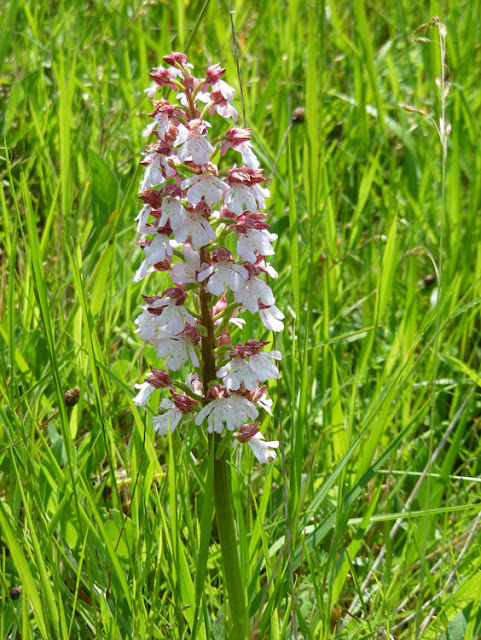 |
| Monkey/Lady Orchid hybrid Orchis x angusticruris. |
 |
| Monkey Orchid Orchis simia (Fr. Orchis singe). |
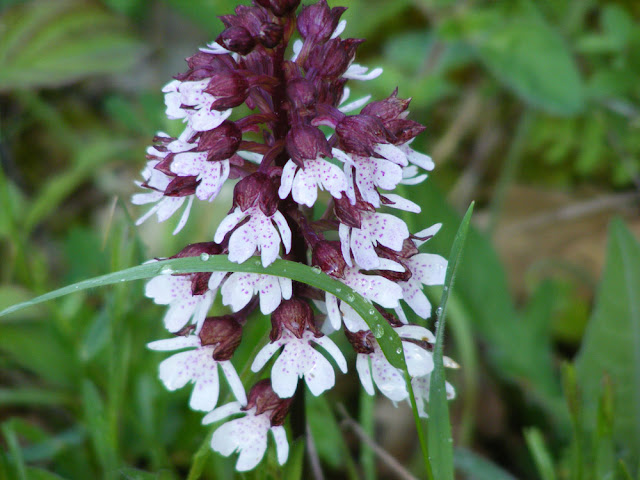 |
| Lady Orchid Orchis purpurea (Fr. Orchis pourpre). |
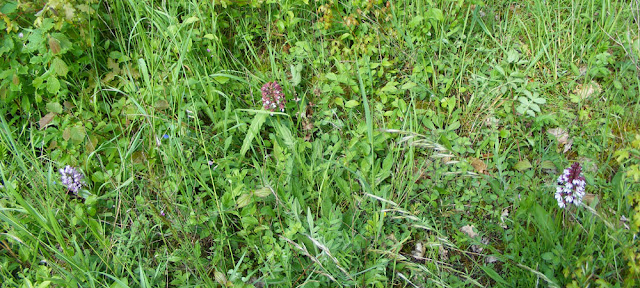 |
| Monkey Orchid (left), hybrid (centre) and Lady Orchid (right). |
 |
| Hypochromatic Monkey Orchid Orchis simia (Fr. Orchis singe), with a ruby-tailed wasp Chrysidae. |
 |
| Monkey Orchid Orchis simia (Fr. Orchis singe). |
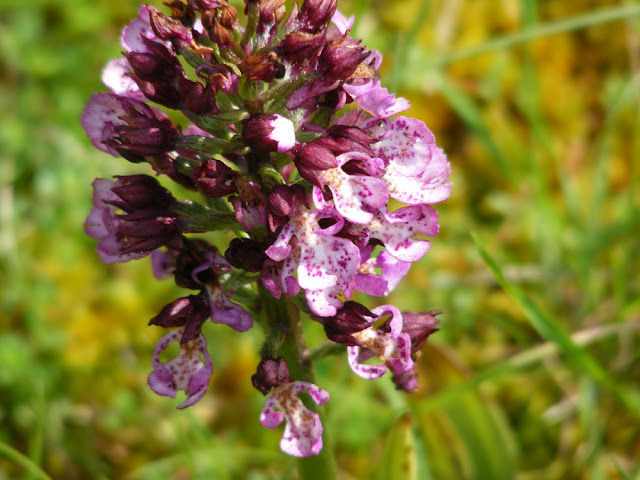 |
| Monkey/Lady Orchid hybrid Orchis x angusticruris. |
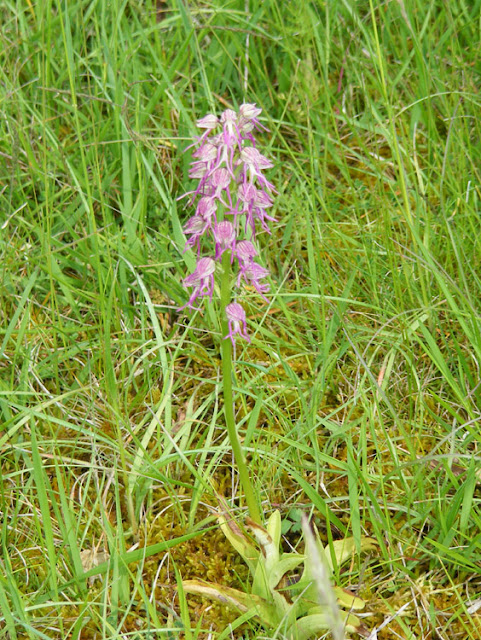 |
| Monkey/Man Orchid hybrid Orchis x bergonii. |
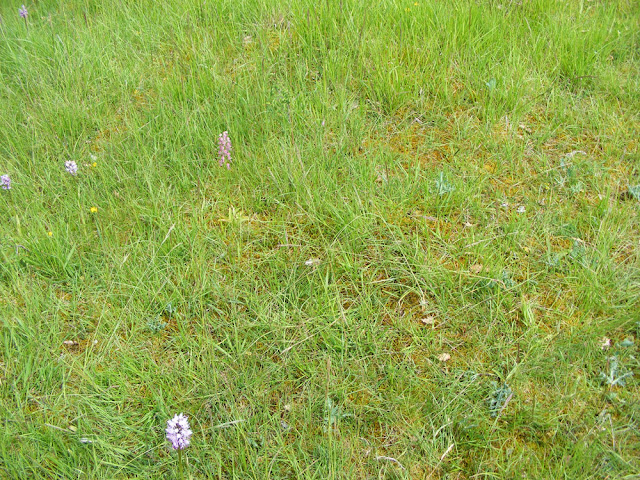 |
| Hybrid Monkey/Man Orchid with parent species. |
 |
| Monkey/Man Orchid hybrid Orchis x bergonii. |
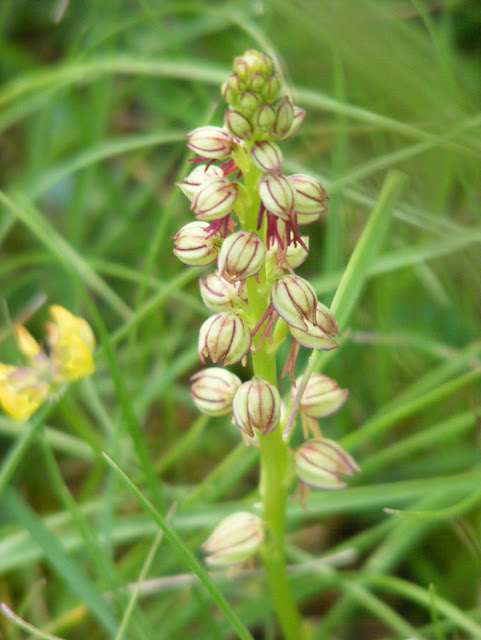 |
| Man Orchid Orchis anthopophora (Fr. Homme-pendu). |
Thursday, 9 May 2024
Filming in Town
Recently the comedy duo Les Bodins filmed sequences of their new film in Preuilly. Apparently it's about the biggest goats cheese in the world and events that go rather wrong. The market square was given a makeover and several of my friends were extras (Fr. figurants). Lieutopie, the community café, was paid €200 as compensation by the film company because one Saturday they were unable to open, and they were quite happy with that. By all accounts it was a fun time and the stars made themselves very accessible. There were lots of selfies with and without the main characters circulating on social media. As I passed on various errands I took the opportunity to photograph whatever the action at the time was.
The pizza kiosk on the right is part of the film set. It was erected and painted over the course of a couple of days prior to the filming.
Many of the market stalls were our real regular traders. This is my friend Sandy's organic apple stall, just zhuzhed up a bit with pretty baskets. Sandy normally uses ordinary fruit boxes to lay out and display the apples. She'd be forever refilling baskets like this in real life!
The bunting was provided by the film company.
This stall is completely the work of the film crew.
The tarpaulin wrapped object in the middle of the photo is the 'giant cheese' (naturally, a log shaped goats cheese).
Packing up.
I see that my friend Catherine's house was turned into the town hall, and the apartment next door became a real estate agent.
Packing up the last few props.



.jpg)













